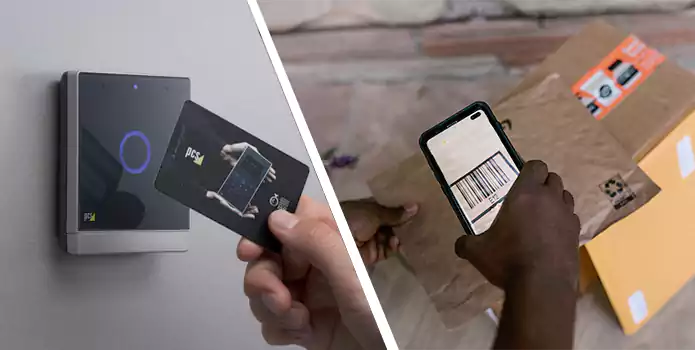RFID and barcodes are both technologies that carry data and are two technologies that are often used for asset tracking and inventory tracking. These technologies are used in several industries such as retail, transportation, apparel, manufacturers, anti-counterfeiting, etc. Knowing the major differences between RFID and barcode is a necessary need for running the business successfully and to enhance your Return on Investment (ROI).
What is Barcode?
Barcode is a type of code that is machine-readable i.e. a machine-code/machine language in the structure of numbers and a pattern of parallel lines of various widths, printed on a commodity and used specifically for stock control. Barcoding makes use of a scanner with a beam of light to “read” black and white traces of a barcode.
The scanner consists of a sensor that creates a signal from the mirrored or reflected light, and a decoder then interprets sign into textual content and sends it to a PC or database. Barcode scanners require line of sight and ought to “see” every barcode one at a time in order to seize data.
What is RFID?
It is an acronym for “radio-frequency identification” and refers to science whereby digital data encoded in RFID tags or smart labels are captured with aid of a reader by radio waves. In RFID data from a tag or label are captured via a gadget that stores data in a database. RFID, however, has quite a few benefits over systems that use barcode asset monitoring software. The most incredible is that RFID tag statistics can be examined outside line-of-sight.
An RFID tag incorporates a sensor connected to an antenna that allows the transmission of data to the reader. Each sensor carries a unique identifier and an RFID reader that can concurrently scan a lot of tags.
How do barcode and RFID tracking work?
Barcodes use a scanner with a beam of light to detect the black and white lines of a barcode. The scanner can decode the lines, turn them into text, and send the information to a computer database for later analysis. Scanners have to “see” every line of the code to accurately read and transmit the data.
RFIDs also facilitate the reading and sending of information. RFID technologies use radio waves to transmit data from RFID tags (typically small chips that are input into sensors) to an RFID reader. Each sensor is unique, and RFID readers can scan several at one time.
How to Choose Between RFID and Barcodes?
When it comes to choosing which system is right for your business needs, you’ll want to consider the following:
- What you’re tracking
- How secure you need the information you’re tracking to be
- How and where your inventory tracking will take place
- What your budget for this process looks like
What are the advantages & disadvantages of barcodes?
The advantages of the barcode are as follow:
- They are cost-effective
- Barcode is very accurate
- Barcode is a universal technology
- It is vastly used in Inventory Tracking
- It removes the possibility of human mistake or error
- They can be ready by barcode scanner from anywhere across the world
- Barcode is easy to use technology as you can see it on almost every product and item
The disadvantages of the barcode are as follow:
- It needs to be scanned in a straight line
- If the barcode is tempered there is no other way to scan the product
- Barcode only stores a small amount of data
- The Barcode scanner needs to stay close to the product in order to scan the barcode
What are the advantages & disadvantages of RFID?
The advantages of RFID are as follow:
- RFID technology automates data collection and vastly reduces human effort and error
- RFID supports tag reading with no line-of-sight or item-by-item scans required
- RFID readers can read multiple RFID tags simultaneously, offering increases in efficiency
- All RFID tags within range can be detected instantly and matched with information in your database
- Assets can be cross-referenced against assigned locations and recorded as present, missing, or relocated
- RFID can be integrated with active scanning and fixed readers for a totally automated tracking solution
- Assets and employees can be tracked and located automatically for everything from supply chain and asset management to facility security and emergency planning
- Available scanners support both RFID and barcoding so you can upgrade at your own pace
- RFID tags are reusable because they are covered with plastic
The Disadvantages of RFID are as follow:
- The impact of the signal is vulnerable by material such as liquid and metal
- Sometimes it accidentally scans the data
- RFID tag cost is much higher than barcode as there is an inbuilt chip inside the tag
- RFID Implementation is time-consuming
What are the similarities between Barcode and RFID?
- Both technologies are used for asset tracking & inventory tracking.
- RFID and barcode are the two asset tracking methods for gathering & collecting information data
- Stored information on both are retrieved via another device (scanner or reader)
What are the differences between Barcode and RFID?
| Item | Barcode | RFID |
|---|---|---|
| Read Rate | Only one at a time | 10’s, 100’s, or 1000’s simultaneously |
| Read Range | Several inches upto several feet | Passive UHF RFID: -UP to 40 feet (fixed readers) -UP to 20 feet (handheld readers) Active RFID -UP to 100’s of feet or more |
| Read Speed | Slow | Very fast(ms) |
| Readable through objects | No,must be line of sight | Yes |
| Identification | Most barcodes only identify the type of item (UPS Code) but not uniquely | Can uniquely identify each item/asset tagged |
| Technology | Optical(Laser) | Radio Frequency |
| Line of site | Required | Not required |
| Interference | Moat barcode scanners require a human to operate (labor intensive) | Most “fixd” readers don’t require human involvement to collect data (automated) |
THE ADVANTAGES OF BARCODE OVER RFID
1.Accuracy
While it is helpful to have an RFID scanner that can scan multiple codes at a time, this may sacrifice accuracy. Barcodes can read codes regardless of the substance, while RFIDs may not correctly read tags when placed on metals or liquids. The radio waves emitted from the RFID tags may not be as accurate as directly scanning each barcode. Speed is fantastic, but not at the expense of accuracy.
2. Cost
RFID are not cheap when it comes to implementation. The sophistication of the technology used can cost companies a considerable amount of money. Savvy businesses can grab barcodes that are a couple of cents each while RFID tags may cost upwards of $0.08-$30.
In addition, companies need pricey printers to print and encode RFID tags as well as equipment that all companies may not have the resources for which to invest. Companies may also have to spend the money and time to train employees on how to work with and properly use this technology.
3. Logistics
Barcodes are processed individually, so it is easy to differentiate products across price and brand. It may seem like a lot of work to individually scan items, but RFIDs are not always the most comfortable option. RFIDs allow you to “read” multiple things, but it is not easy to differentiate what has been scanned and what still needs to be recorded. For example, if there is a large group of boxes on pallets throughout a warehouse, it is not always possible to know if you missed a package or need to rescan something. It might even be necessary to create RFID barriers to ensure you do not scan an item more than once.
4. Lack of privacy
Proponents of RFID feel RFID tags encourage privacy and security because of the sophistication of the tags and scanning technology. However, the distance at which you can scan and record items brings a security issue. If someone can hack into an RFID network or even have a reader, they can potentially steal sensitive information without being detected. This situation makes it imperative to carefully monitor the area for suspicious activity because intelligent hackers with malicious intent can make life difficult for companies using RFIDs.
5. More widely used
While RFIDs have gained in popularity, they are still not as widely used as barcodes. If a company is working with a vendor or supplier, they might have to figure out a way to integrate their RFID usage with their barcode system. Barcodes are still the chosen system of tracking for many companies, and they may not have the infrastructure to work with an RFID system. This situation means companies who use RFIDs may potentially have a limited group of suppliers and vendors they can work with because of the difference in tracking systems.
THE ADVANTAGES OF RFID OVER BARCODE
1.SPEED
Beyond any doubt, there is a huge performance gap between barcode and RFID when it comes to speed. This is a direct consequence of individual scanning (barcode) vs. scanning multiple items at once (RFID).
The video below highlights how much faster inventory management can be done with RFID.
2.ACCURACY
Accuracy is harder to assess, because barcode requires manual reading, and is, therefore, more subject to human error. However, RFID might not be as accurate if the tags are placed on metals and liquids. In most circumstances, RFID can guarantee up to 100% inventory accuracy. A study comparing the use of RFID and barcode in the same environment confirmed that RFID guarantees more consistent results.
3.AUTOMATION
When you use RFID, you can automate inventory management and item tracking. As RFID tags can store and share more information than barcode tags, an RFID-powered system allows you to leverage the data better. Better access to higher quality data allows you to use automation to optimize not only inventory management but also your sales cycle.
However, there are still environments where using only barcodes or a mix of barcodes and RFID is preferable. In fact, barcode still dominates many industries. When we ask if the barcode is better than RFID or the other way round, we are often asking the wrong question.
Whether RFID or barcode is better for your needs should be determined by looking at the specific circumstances of your business.
References
- RFID vs. Barcode: What makes them different? A detailed breakdown
- Difference between RFID and Barcode – GeeksforGeeks
- Barcodes vs RFID: Why Barcodes Still Win – Brightpearl
- Advantages of RFID vs Barcodes – AB&R®
- How To Buy RFID Tags – An All-Inclusive RFID Tag Buying Guide
- Learn All About Different Types Of RFID Tags
- The Beginner’s Guide To RFID
- RFID VS Barcode: Which One Is Better For Your System?
- Top 15 Benefits Of Using RFID For Events
- Unique Features And Benefits Of Custom RFID Tags
- Here’s Everything You Want To Know About RFID Tags
- Music Festival RFID Bracelets Make Management Easier


